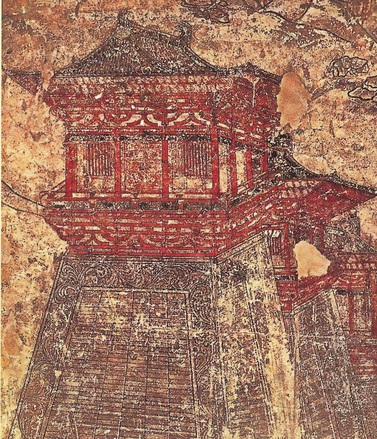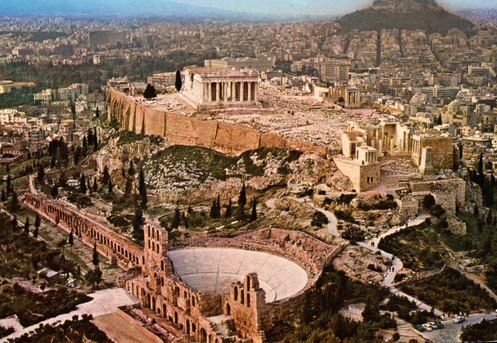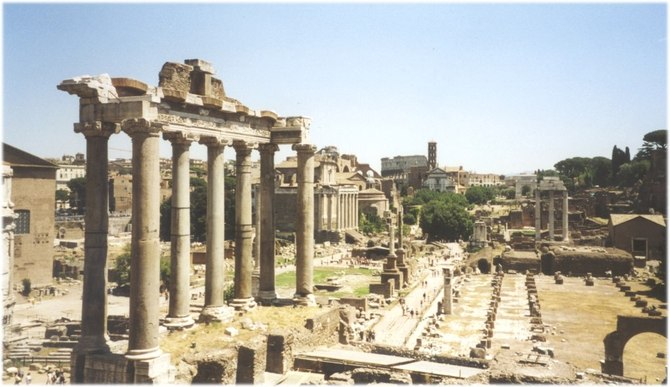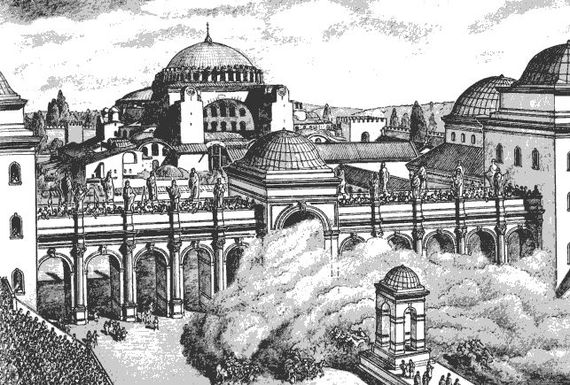Persepolis
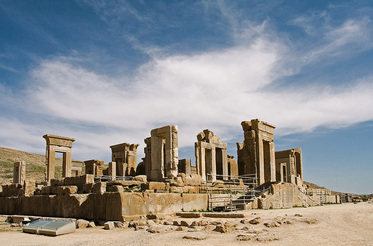
Persepolis is the Greek name for the city of Parsa. The word comes from Perses “polis” for “Persian City”. It is located about seventy miles north of Shiraz in what I present-day Iran. Parsa meant City of the Persians and construction of it began in 518 BCE under rule of Darius I or Darius the Great. He reigned from 522 to 486 BCE. Parsa was made the new capital of the Persian Empire. The old capital was Pasargadae, where King Cyrus the Great was buried. Travel to Parsa was nearly impossible due to its location in the mountains, especially during the rainy season in the winter. Administration of the city was overseen from Susa and Babylon during the cold seasons. In fact, the Greeks never knew of Parsa until it was sacked and looted by Alexander the Great in 330 BCE.
Building began under Darius’ rule but the riches and city that Alexander found when he invaded was established by Xerxes I and Artaxerxes III. Their names were inscribed on tablets over doorways and in hallways around the city.
Persepolis was built in terraces from the river Pulwar and rose over 125,000 sq. ft., being partly cut into the mountain Kuh-e Rahmet. Large depressions were filled with heavy rocks and soil to level the terrace. In 515 BCE, the construction of a stairway to the palace doors was started. The dual entrance of the palace, the Persepolitan stairway, was a work of symmetry on the western side of the building. The steps were so grand that Persian royalty could go up or down the stairs on horseback and would not have to touch the ground with their feet.
Xerxes I built a great palace which consisted of a grand hall that was 82 ft. long with four large columns on the entrance on the Western Wall. Here, nations and people subject to the Empire paid tribute to the king. Limestone was the main building material used. Once the rock had been leveled, tunnels for sewage were made underground through the rock. A very big cistern was carved at the eastern foot of the mountain to catch rain water so people could bathe and drink.
The walls built around the city made it easy to defend any section. The walls were very high, had fortified towers, and were always manned. With the fortifications, it is difficult to believe that Alexander the Great managed to overthrow it. The fire that went over Persepolis completely wiped out everything except the columns, stairways and doorways. The fire destroyed the religious works of Persians written on cow-skins and their works of art. The city was destroyed under the weight of its own ruin and was lost. It became known as the place of the forty columns until 1618. In 1931, excavations revealed the glory of what had been Persepolis. There is no real estimate of the population but it is believed to have been in the thousands.
http://www.ancient.eu.com/persepolis/
http://heritageinstitute.com/zoroastrianism/persepolis/index.htm
Building began under Darius’ rule but the riches and city that Alexander found when he invaded was established by Xerxes I and Artaxerxes III. Their names were inscribed on tablets over doorways and in hallways around the city.
Persepolis was built in terraces from the river Pulwar and rose over 125,000 sq. ft., being partly cut into the mountain Kuh-e Rahmet. Large depressions were filled with heavy rocks and soil to level the terrace. In 515 BCE, the construction of a stairway to the palace doors was started. The dual entrance of the palace, the Persepolitan stairway, was a work of symmetry on the western side of the building. The steps were so grand that Persian royalty could go up or down the stairs on horseback and would not have to touch the ground with their feet.
Xerxes I built a great palace which consisted of a grand hall that was 82 ft. long with four large columns on the entrance on the Western Wall. Here, nations and people subject to the Empire paid tribute to the king. Limestone was the main building material used. Once the rock had been leveled, tunnels for sewage were made underground through the rock. A very big cistern was carved at the eastern foot of the mountain to catch rain water so people could bathe and drink.
The walls built around the city made it easy to defend any section. The walls were very high, had fortified towers, and were always manned. With the fortifications, it is difficult to believe that Alexander the Great managed to overthrow it. The fire that went over Persepolis completely wiped out everything except the columns, stairways and doorways. The fire destroyed the religious works of Persians written on cow-skins and their works of art. The city was destroyed under the weight of its own ruin and was lost. It became known as the place of the forty columns until 1618. In 1931, excavations revealed the glory of what had been Persepolis. There is no real estimate of the population but it is believed to have been in the thousands.
http://www.ancient.eu.com/persepolis/
http://heritageinstitute.com/zoroastrianism/persepolis/index.htm
Chang'an
Chang’an (also known as Xi’an) is the central location of what is now the Shaanxi Province by the intersections of the Wei and Feng rivers. The area was the site of many important imperial capitals for a millennium of china’s history. The first real unified empire of the Chinese of the Qin dynasty was just to the north of Chang’an. In 202 BCE, the construction of Chang’an began. It played a very important role in the beginning of the Silk Road and the capital was expanded with many new palaces that were built. The city, however, collapsed during the fall of the Han dynasty and was burned. It became an ordinary city and the capital was moved to Luoyang.
The city of Chang’an was revived in the fourth century and became the capital once again. It became a center for Buddhist learning and experienced a rise in culture. Many important Buddhists traveled to the city and resided there around the start of the fifth century. The revival ended due to civil issues for over a century when an army conquered the city in 417. It had a small revival during the sixth century but ended once more with the Sui dynasty in 581 when the Sui emperor decided to build a new city south of Han Chang’an, where the current Xi’an lies. The choice of the new site and layout of the city was based on divination and reference to astrological signs.
The city had the best period of its development under the Tang dynasty. During this time, it was the most cosmopolitan, populous and civilized city in the world according to Richard B. Mather, author of Xiong. The city occupied 84 square kilometers and had about one million inhabitants. The city did however; suffer damage during the Lushan rebellion during the mid-8th century. The city still managed to impress visitors and outsiders with its size even when the empire was having problems. The city was important trade and played an important role in the exchange of goods. The dominant figures in the capital city under the early Tang were the Soghdian merchants from Central Asia. There were many markets and the streets were always busy with merchants and buyers.
The city was a major religious center under the Tang dynasty. Not only Buddhism and Taoism flourished but many other religions that had arrived in China such as Zoroastrianism, Nestorians, and Manichaeism. The Islam community took root during the Ming period and became very large. Many Muslim merchants lived in china. Chang’an greatest mosque, the Qing Zhen Dasi, was built in 742. Many of the mosques built in China portray Chinese architecture so the Chinese Muslims became largely enveloped in the culture.
http://depts.washington.edu/silkroad/cities/china/xian/xian.html
The city of Chang’an was revived in the fourth century and became the capital once again. It became a center for Buddhist learning and experienced a rise in culture. Many important Buddhists traveled to the city and resided there around the start of the fifth century. The revival ended due to civil issues for over a century when an army conquered the city in 417. It had a small revival during the sixth century but ended once more with the Sui dynasty in 581 when the Sui emperor decided to build a new city south of Han Chang’an, where the current Xi’an lies. The choice of the new site and layout of the city was based on divination and reference to astrological signs.
The city had the best period of its development under the Tang dynasty. During this time, it was the most cosmopolitan, populous and civilized city in the world according to Richard B. Mather, author of Xiong. The city occupied 84 square kilometers and had about one million inhabitants. The city did however; suffer damage during the Lushan rebellion during the mid-8th century. The city still managed to impress visitors and outsiders with its size even when the empire was having problems. The city was important trade and played an important role in the exchange of goods. The dominant figures in the capital city under the early Tang were the Soghdian merchants from Central Asia. There were many markets and the streets were always busy with merchants and buyers.
The city was a major religious center under the Tang dynasty. Not only Buddhism and Taoism flourished but many other religions that had arrived in China such as Zoroastrianism, Nestorians, and Manichaeism. The Islam community took root during the Ming period and became very large. Many Muslim merchants lived in china. Chang’an greatest mosque, the Qing Zhen Dasi, was built in 742. Many of the mosques built in China portray Chinese architecture so the Chinese Muslims became largely enveloped in the culture.
http://depts.washington.edu/silkroad/cities/china/xian/xian.html
Pataliputra
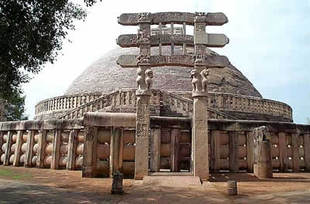
Pataliputra is the ancient name for Patna, present day capital of Bihar. The city has had many names such as Pataligram, Palibothra, Kusumpur, and a few others. The name Pataliputra comes from the Sanskrit word pattan, which means port or from the word patali, meaning trumpeter flower in honor of Patali a legendary queen. Two other names of the city also mean City of Flowers. It was located on the south bank of the Ganga River. Trade was always an important part of the city because of its location near three large rivers. The legend of Pataliputra is that it was magically created by King Putraka, a mythological figure, for his queen, Patali. When they had their first son, the King named it Pataliputra since putra means son. Its history begins with Ajashatru the second Magadhan king. He established a fort in 490 BCE where the rivers met to fight off enemies more effectively. According to Buddhist texts, the Buddha went to Pataliputra during the construction of the fort when he was journeying north.
Chandragupta Maurya ruled the kingdom from 322 to 301 BCE. The Greek ambassador Megasthenes described it as the greatest city in India. The city was laid out in the shape of a parallelogram. It was surrounded by a wooden wall with 570 towers and sixty-four gates. Agriculture was important in the area and there were social divisions among the people. The government was highly centralized. The bureaucracy was administered by military officials and there was a system of taxation for agricultural production, real estate, and trade. Many of the wooden structures were replaced by stone and universities as well as monasteries were built. Trade routes linked the port to Ceylon, Malaysia, and the Far East. It was also connected to Taxila in the north by the Royal Highway.
The Gupta dynasty began with Chandra Gupta from 320-335 BCE. He established the capital and his son reigned for fifty years. The Gupta influence was expanded by them over twenty kingdoms. There was a lot of religious tolerance to the king of Ceylon was able to build a Buddhist monastery. Chandra Gupta II continued the expansion of the empire towards the west and set up a second capital in Ujjain which is in central India. The caste system was developed based on the interpretation of the Hindu scriptures. The era is considered the Golden Age of Indian culture, as scholarship and the arts were greatly supported. Fa-Hien, a Chinese Buddhist from Chang’an traveled to India and visited Pataliputra many times. The traveler found the city to be beautiful and thought the region was rich and prosperous. He was, however, surprised that there was a lack of taxes and no capital punishment.
The Guptas disintegrated with the invasion of the Huns. Some Guptas still had control over Pataliputra over another hundred years but were later overcome by the Vardhanas. Pataliputra had become part of the Delhi Sultanate by the mid-12th century. During the Mughal period, it continued to be ruled from Delhi. The city became the international trading center under the control of the Nawabs of Bengal once the Mughal Empire declined in the 17th century. Today, Patna is a powerful city with over one million people. It is a popular pilgrimage and tourist destination as well as a center for business.
http://www.ancientworlds.net/aw/Places/Place/419417
Chandragupta Maurya ruled the kingdom from 322 to 301 BCE. The Greek ambassador Megasthenes described it as the greatest city in India. The city was laid out in the shape of a parallelogram. It was surrounded by a wooden wall with 570 towers and sixty-four gates. Agriculture was important in the area and there were social divisions among the people. The government was highly centralized. The bureaucracy was administered by military officials and there was a system of taxation for agricultural production, real estate, and trade. Many of the wooden structures were replaced by stone and universities as well as monasteries were built. Trade routes linked the port to Ceylon, Malaysia, and the Far East. It was also connected to Taxila in the north by the Royal Highway.
The Gupta dynasty began with Chandra Gupta from 320-335 BCE. He established the capital and his son reigned for fifty years. The Gupta influence was expanded by them over twenty kingdoms. There was a lot of religious tolerance to the king of Ceylon was able to build a Buddhist monastery. Chandra Gupta II continued the expansion of the empire towards the west and set up a second capital in Ujjain which is in central India. The caste system was developed based on the interpretation of the Hindu scriptures. The era is considered the Golden Age of Indian culture, as scholarship and the arts were greatly supported. Fa-Hien, a Chinese Buddhist from Chang’an traveled to India and visited Pataliputra many times. The traveler found the city to be beautiful and thought the region was rich and prosperous. He was, however, surprised that there was a lack of taxes and no capital punishment.
The Guptas disintegrated with the invasion of the Huns. Some Guptas still had control over Pataliputra over another hundred years but were later overcome by the Vardhanas. Pataliputra had become part of the Delhi Sultanate by the mid-12th century. During the Mughal period, it continued to be ruled from Delhi. The city became the international trading center under the control of the Nawabs of Bengal once the Mughal Empire declined in the 17th century. Today, Patna is a powerful city with over one million people. It is a popular pilgrimage and tourist destination as well as a center for business.
http://www.ancientworlds.net/aw/Places/Place/419417
Athens
Athens was one of the most powerful and important cities in classical Greece. It was the first of the city states in Greece to develop full democracy. It was important that Athenians took an active part in running of the government. Even though Athens had a fully developed democracy, not everyone could vote. Male citizens in Athens could vote on the decisions that would take place in the city and could serve on juries. Women and children were not allowed to vote and slaves and foreigners were banned from voting as well.
http://www.ancientgreece.co.uk/athens/home_set.html
Athens was the largest city at the time in Greece and controlled a region known as Attica. It lied between many mountains with farms and fertile valleys. Athens became wealthy because Attica had many resources such as silver, lead, and marble. Athens also had the largest navy in Greece. The city was busy and beautiful and people came from all over the world to study and trade. The most famous building is the temple known as the Parthenon. The Parthenon was on a rocky hill called the Acropolis. In the Parthenon, there was a statue pf Athena, the city’s protector goddess.
There were 250,000 to 300,000 people in Athens and of them, a third of them were slaves. Many slaves were captured in wars and many were born into slavery. Some people were forced into slavery when they did not pay their dues and owed money. Many slaves were owned by the state and were part of the Athenian police to the Athenian government. Some slaves acquired skills and became nurses, teachers, and pottery painters. They did execute the hardest jobs as well as the most unpleasant ones.
There were yearly festivals in athletics, drama, and religious occasions held in Athens. The costs of the festivals were paid by the taxes which citizens paid, but the wealthier people paid more in order to hold these events. In Athens, the important people were the stategoi who were generals chosen from ten tribes of citizens. Nine archons also held jobs which were mostly ceremonial and took care of festivals and family matters. Archons had to organize Dionysian Festival for the god Dionysus every year. This festival was the most famous in Athens. There were a lot of fun, wine-drinking, parties, and especially plays. Military service was important and any man aged twenty to fifty could be called into service. Rich men could also serve for a year; he would merely pay for the crew and make repairs.
http://www.bbc.co.uk/schools/primaryhistory/ancient_greeks/athens/
http://www.ancientgreece.co.uk/athens/home_set.html
Athens was the largest city at the time in Greece and controlled a region known as Attica. It lied between many mountains with farms and fertile valleys. Athens became wealthy because Attica had many resources such as silver, lead, and marble. Athens also had the largest navy in Greece. The city was busy and beautiful and people came from all over the world to study and trade. The most famous building is the temple known as the Parthenon. The Parthenon was on a rocky hill called the Acropolis. In the Parthenon, there was a statue pf Athena, the city’s protector goddess.
There were 250,000 to 300,000 people in Athens and of them, a third of them were slaves. Many slaves were captured in wars and many were born into slavery. Some people were forced into slavery when they did not pay their dues and owed money. Many slaves were owned by the state and were part of the Athenian police to the Athenian government. Some slaves acquired skills and became nurses, teachers, and pottery painters. They did execute the hardest jobs as well as the most unpleasant ones.
There were yearly festivals in athletics, drama, and religious occasions held in Athens. The costs of the festivals were paid by the taxes which citizens paid, but the wealthier people paid more in order to hold these events. In Athens, the important people were the stategoi who were generals chosen from ten tribes of citizens. Nine archons also held jobs which were mostly ceremonial and took care of festivals and family matters. Archons had to organize Dionysian Festival for the god Dionysus every year. This festival was the most famous in Athens. There were a lot of fun, wine-drinking, parties, and especially plays. Military service was important and any man aged twenty to fifty could be called into service. Rich men could also serve for a year; he would merely pay for the crew and make repairs.
http://www.bbc.co.uk/schools/primaryhistory/ancient_greeks/athens/
Carthage
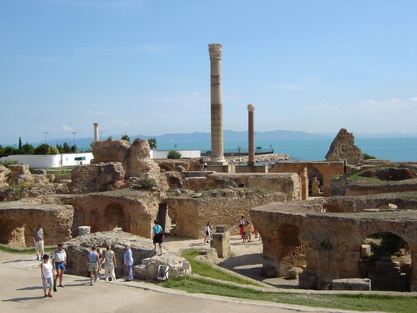
Carthage was, according to legend, founded by the Phoenician Queen Elissa in 813 BCE. The city is located in modern-day Tunisia in North Africa. It was known as Karthadasht which meant new city. It was known with this name to distinguish it among the older city of Utica nearby. The Greeks called it Karchedon and the Romans called it Carthago. It was originally a small port on the coast for Phoenician traders but grew to be the most powerful city in the Mediterranean before the rise of Rome.
After the fall of the city Tyre to Alexander the Great in 332 BCE, Tyrians fled to Carthage. Most of the people who were able to flee were rich so they were able to establish Cartage as the new center for Phoenician trade. Carthaginians drove the natives from the area and enslaved many of them. It became the richest city in the Mediterranean before one hundred years. Aristocrats lived in palaces and tribute and tariffs were increased with the wealthiest on top that based their business in trade. The harbor had 220 docks and was decorated with Greek sculptures. The trading ships sailed every day while the navy kept the ports safe and opened new land for trade and resources.
The expansion made was what brought Carthage into conflict with Rome. The Carthaginian navy was able to enforce a treaty made with Rome but when they took Sicily, Rome did respond. Rome had no navy but built 330 ships and turned a sea battle into a land battle. These wars were called the Punic Wars. The first one lasted from 264-241 BCE. Rome won a series of victories and defeated Carthage in 241 BCE.
After the Punic war, Carthage took place in the Mercenary War which began when the Carthaginian army of mercenaries demanded payment that was owed to them by Carthage. Carthage suffered from the wars and Rome then occupied some Carthaginian colonies. The second Punic war was fought in northern Italy as Hannibal tried invading Italy. Hannibal won all battles against the Romans in Italy. He did lack sufficient troops and supplies and could not build on and was defeated by Africanus in North Africa so the city had to sue for peace once more.
Carthage struggled to pay debts while fighting other wars. They took place in a third Punic war until the city fell. The Romans then burned it to the ground. Utica became the capital of Rome’s African provinces and Carthage was in ruins until 122 BCE when a Roman tribune founded a small colony there. Julius Cesar proposed and planned the re-building of Carthage and after he passed away, Carthage rose once more. Power was given back to Carthage until the empire fell. The city later on rose during the Byzantine Empire. In 698 BCE, however, the Muslims defeated the Byzantines from Africa and destroyed the city completely. Carthage lies in ruin in modern day Tunisia and is an important tourist attraction as well as archaeological site.
http://www.ancient.eu.com/carthage/
After the fall of the city Tyre to Alexander the Great in 332 BCE, Tyrians fled to Carthage. Most of the people who were able to flee were rich so they were able to establish Cartage as the new center for Phoenician trade. Carthaginians drove the natives from the area and enslaved many of them. It became the richest city in the Mediterranean before one hundred years. Aristocrats lived in palaces and tribute and tariffs were increased with the wealthiest on top that based their business in trade. The harbor had 220 docks and was decorated with Greek sculptures. The trading ships sailed every day while the navy kept the ports safe and opened new land for trade and resources.
The expansion made was what brought Carthage into conflict with Rome. The Carthaginian navy was able to enforce a treaty made with Rome but when they took Sicily, Rome did respond. Rome had no navy but built 330 ships and turned a sea battle into a land battle. These wars were called the Punic Wars. The first one lasted from 264-241 BCE. Rome won a series of victories and defeated Carthage in 241 BCE.
After the Punic war, Carthage took place in the Mercenary War which began when the Carthaginian army of mercenaries demanded payment that was owed to them by Carthage. Carthage suffered from the wars and Rome then occupied some Carthaginian colonies. The second Punic war was fought in northern Italy as Hannibal tried invading Italy. Hannibal won all battles against the Romans in Italy. He did lack sufficient troops and supplies and could not build on and was defeated by Africanus in North Africa so the city had to sue for peace once more.
Carthage struggled to pay debts while fighting other wars. They took place in a third Punic war until the city fell. The Romans then burned it to the ground. Utica became the capital of Rome’s African provinces and Carthage was in ruins until 122 BCE when a Roman tribune founded a small colony there. Julius Cesar proposed and planned the re-building of Carthage and after he passed away, Carthage rose once more. Power was given back to Carthage until the empire fell. The city later on rose during the Byzantine Empire. In 698 BCE, however, the Muslims defeated the Byzantines from Africa and destroyed the city completely. Carthage lies in ruin in modern day Tunisia and is an important tourist attraction as well as archaeological site.
http://www.ancient.eu.com/carthage/
Rome
Rome’s legend of origin is that it was founded by Romulus and Remus, twin sons of Mars who was known as the god of war. They were left to drown in a basket by a king of nearby. The twins lived to defeat the king and founded their city on the river’s banks in 753 BCE. Romulus killed his brother and became the first king of Rome.
Politics in the early republic were marked by the fight between patricians and the common people. In 450 BCE, the first Roman law code was inscribed on twelve bronze tablets called the Twelve Tables. The laws included issues of civil rights, legal procedure, and property rights which provided the basis for all future Roman civil law. By 300 BCE, the Senate was the center of political power. Only men of patrician and wealthy plebeian could be members of the Senate. The roman state was central and had expectations of citizens. Citizens had to serve in the military and had to obey the state.
Rome grew in size and in power during the early republic. Rome fought a series of battles known as the Punic Wars against Carthage. Its military conquest led to its growth of culture and society. They benefited a lot from contact with advanced cultures such as the Greeks. Roman literature appeared around 240 BCE with translations of Greek classics to Latin.
Rome went from a republic to an empire. It was led by many military dictators, one of the most famous being Julius Caesar. He expanded the empire to include central and Western Europe. Caesar directed the construction of a wooden bridge to enable troops to invade and conquer central Europe. Under Caesar Augustus’ rule, Rome entered into pax romana, or peace under Rome. This brought a long era of stability and Rome as well as culture.
Rome was largely known for its engineering and for its architect. The architecture was built to accommodate the one million people who lived in Rome at the time. There were many buildings designed for entertainment such as the Coliseum and many amphitheaters. They are also known for their construction of paved roads and for the aqueducts built to supply Rome with water. The Romans used brick to construct and would then use marble over the brick.
http://www.slideshare.net/PaulVMcDowell/classical-rome-presentation-747984
www.history.com/topics/ancient-rome
Politics in the early republic were marked by the fight between patricians and the common people. In 450 BCE, the first Roman law code was inscribed on twelve bronze tablets called the Twelve Tables. The laws included issues of civil rights, legal procedure, and property rights which provided the basis for all future Roman civil law. By 300 BCE, the Senate was the center of political power. Only men of patrician and wealthy plebeian could be members of the Senate. The roman state was central and had expectations of citizens. Citizens had to serve in the military and had to obey the state.
Rome grew in size and in power during the early republic. Rome fought a series of battles known as the Punic Wars against Carthage. Its military conquest led to its growth of culture and society. They benefited a lot from contact with advanced cultures such as the Greeks. Roman literature appeared around 240 BCE with translations of Greek classics to Latin.
Rome went from a republic to an empire. It was led by many military dictators, one of the most famous being Julius Caesar. He expanded the empire to include central and Western Europe. Caesar directed the construction of a wooden bridge to enable troops to invade and conquer central Europe. Under Caesar Augustus’ rule, Rome entered into pax romana, or peace under Rome. This brought a long era of stability and Rome as well as culture.
Rome was largely known for its engineering and for its architect. The architecture was built to accommodate the one million people who lived in Rome at the time. There were many buildings designed for entertainment such as the Coliseum and many amphitheaters. They are also known for their construction of paved roads and for the aqueducts built to supply Rome with water. The Romans used brick to construct and would then use marble over the brick.
http://www.slideshare.net/PaulVMcDowell/classical-rome-presentation-747984
www.history.com/topics/ancient-rome
Alexandria
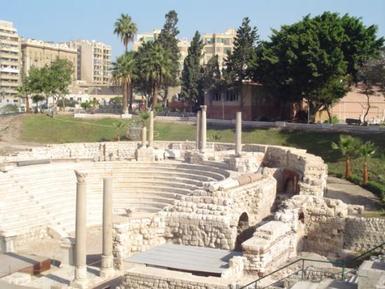
Alexandria was founded by Alexander the Great in 332 BCE. The city was added to the ancient city of Rhacotis and a suburb called Neapolis. The plan for Alexandria was to provide a naval base for Alexander on his assault on Persia. It also served to link Macedonia and the Nile valley. When Alexander died in 323 BCE, Ptolemy, one of his generals, took Egypt as his own and Alexander was taken to Alexandria to be buried. Alexandria was made the most cosmopolitan and sophisticated city in the ancient world. The library at Alexandria had over 500,000 scrolls of history and philosophy and was a core meeting place for scholars from all over.
http://www.halexandria.org/dward019.htm
Alexandria had access to many pure elements including gold, silver, iron, copper, tin lead, mercury, sulfur, arsenic, and carbon. Concepts such as time cost of goods, languages, and art were important to the society in Alexandria. It was a good place for trade and had the wealth and knowledge to build great temples, zoological and botanical gardens, buildings, national archives, and many other structures.
The city was built on a set of great ideas from the teachings of Socrates, Plato, and Aristotle. Life was luxurious and the people who lived there considered it much like a paradise. However, there were problems in Alexandria. A group known as the Alexandrian mob would create chaos where they believed the courts had done wrong or failed. It was made up of merchants, servants, and the wealthy. During the Golden Age of Alexandria, common Egyptians suffered from economic problems. Taxes in place were the highest that were around in the ancient world.
http://www.math.wichita.edu/history/topics/alexandria.html
http://www.halexandria.org/dward019.htm
Alexandria had access to many pure elements including gold, silver, iron, copper, tin lead, mercury, sulfur, arsenic, and carbon. Concepts such as time cost of goods, languages, and art were important to the society in Alexandria. It was a good place for trade and had the wealth and knowledge to build great temples, zoological and botanical gardens, buildings, national archives, and many other structures.
The city was built on a set of great ideas from the teachings of Socrates, Plato, and Aristotle. Life was luxurious and the people who lived there considered it much like a paradise. However, there were problems in Alexandria. A group known as the Alexandrian mob would create chaos where they believed the courts had done wrong or failed. It was made up of merchants, servants, and the wealthy. During the Golden Age of Alexandria, common Egyptians suffered from economic problems. Taxes in place were the highest that were around in the ancient world.
http://www.math.wichita.edu/history/topics/alexandria.html
Constantinople
Diocletian ruled the Roman Empire from 284 to 305 CE but believed the empire was too big for one person to rule and divided in into a rule of four people. Diocletian ruled the east and Constantine ruled the west. He was not sure where to locate the new capital but old Rome was not an option. The infrastructure of the city was decaying and its economy was not in good conditions with its only source of revenue weakening. He then decided to place the new capital where old Byzantium was. The city had many advantages. It was closer to the center of the empire, and was surrounded by water. The location was good for protection and provided a good harbor.
The city was built on seven hills and was four times the size of Byzantium. It was divided into fourteen districts and was supposedly laid out by Constantine. At the intersection of two main streets was the tetraphylon a four-way arch. North of that was the old basilica that had been converted to a square court with a library and to shrines. To the south was the new imperial palace. The city used its meeting hall as a market, stock exchange, and court of law.
Old Rome didn’t have a problem with water and it was one of Constantine’s principal worries. New Rome faced periods of drought in the summer and early autumn. With the weather problems came the possibility of invasion. There were many aqueducts built to bring water into the city but a lack of storage was still a problem. The Binbirderek Cistern was constructed in 330 CE to solve the problem.
Constantine supported Christianity but historians doubt whether he ever became a Christian. New Rome boasted temples to pagan deities and there were many Christian churches, Constantinople became the center of Greek classics and Christian ideals. In 337 CE Constantine died and left his successors and the empire with many problems.
Constantius II defeated his brother and became the empires sole emperor. He expanded the governmental bureaucracy and added quaestors, praetors, and tribunes. He is credited for the first of three Hagias Sophia’s, also known as the Church of Holy Wisdom, in 360 CE. The church was destroyed in 404 CE by fire and was rebuilt by Theodosius II.
The city was taken over by Julia the Apostate after Constantius II’s death. He was the last pagan emperor. He tried erasing all aspects of Christianity but failed and died fighting the e Persians in 363 CE. The empire was split between Valentinian I and Valens. Valen’s successor was Thedosius the Great and outlawed paganism. He made Christianity the official religion of the empire in 391 CE. He was the last emperor to rule both west and east. He eliminated the Vestal Virgins of Rome, got rid of the Olympic Games and dismissed the Oracle at Delphi. His grandson rebuilt Hagia Sophia after it had burned, established a university, and expanded the walls of the city in 413 CE.
http://www.ancient.eu.com/Constantinople/
The city was built on seven hills and was four times the size of Byzantium. It was divided into fourteen districts and was supposedly laid out by Constantine. At the intersection of two main streets was the tetraphylon a four-way arch. North of that was the old basilica that had been converted to a square court with a library and to shrines. To the south was the new imperial palace. The city used its meeting hall as a market, stock exchange, and court of law.
Old Rome didn’t have a problem with water and it was one of Constantine’s principal worries. New Rome faced periods of drought in the summer and early autumn. With the weather problems came the possibility of invasion. There were many aqueducts built to bring water into the city but a lack of storage was still a problem. The Binbirderek Cistern was constructed in 330 CE to solve the problem.
Constantine supported Christianity but historians doubt whether he ever became a Christian. New Rome boasted temples to pagan deities and there were many Christian churches, Constantinople became the center of Greek classics and Christian ideals. In 337 CE Constantine died and left his successors and the empire with many problems.
Constantius II defeated his brother and became the empires sole emperor. He expanded the governmental bureaucracy and added quaestors, praetors, and tribunes. He is credited for the first of three Hagias Sophia’s, also known as the Church of Holy Wisdom, in 360 CE. The church was destroyed in 404 CE by fire and was rebuilt by Theodosius II.
The city was taken over by Julia the Apostate after Constantius II’s death. He was the last pagan emperor. He tried erasing all aspects of Christianity but failed and died fighting the e Persians in 363 CE. The empire was split between Valentinian I and Valens. Valen’s successor was Thedosius the Great and outlawed paganism. He made Christianity the official religion of the empire in 391 CE. He was the last emperor to rule both west and east. He eliminated the Vestal Virgins of Rome, got rid of the Olympic Games and dismissed the Oracle at Delphi. His grandson rebuilt Hagia Sophia after it had burned, established a university, and expanded the walls of the city in 413 CE.
http://www.ancient.eu.com/Constantinople/
Teotihuacán
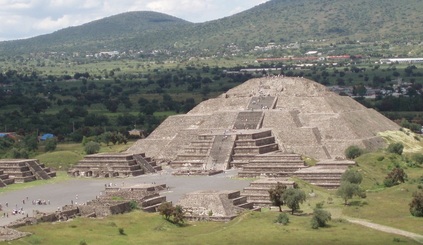
Teotihuacán, Monte Alban, and Cholula were all cities in Mesoamerica that were at their peak during the Golden Age. Religion was the main aspect of the societies and from it, politics, science and culture were derived. The first great culture of the classical period was in the capital of Teotihuacán. The name means “City of the Gods” and is located northeast of present day Mexico City. It had about 100,000 or more inhabitants as well as a defined class structure. The people of Teotihuacán were very knowledgeable of writing and books, a 260-day sacred calendar, and their number system. The society was built on the premise of agriculture, trade, and mining.
Only parts of the area have been excavated but the civic-ceremonial center cover an area of about two square miles. The city was built on a grid plan and had many pyramids, palaces, and temples. The building style is that of “talud-tablero” with sloping walls and decorations. The most famous structures are the Pyramid of the Sun, which are the third largest in the world. The city’s lords and priests lived in grand palaces are located throughout the site. The palaces were decorated with frescoes of many colors.
http://www.mexconnect.com/articles/1960-the-classic-period-300-900-ad-part-1
The people of the city of Teotihuacán believed in many gods and goddesses. Among them were: tlaloc (rain god), chalchiuhticue (water goddess), xipe-totec (“our lord the flayed one”), huehueteotl (god of fire), the sun god, the moon goddess, and quetzalcoatl (god of fertility). These deities were largely connected with events that occurred in the city and with how well the maize was growing. There is evidence of a market with multiple ethnic groups. Crops grown were generally of maize, beans, squash, Chile, cotton, tunas, avocados, and amaranth. They also had a chinampas system, which were floating plant beds on the rivers and waterways. The city was burned in the 7th century by invaders and its influence in other places ceased. There was many internal crisis as well as economic problems in the society.
http://staffwww.fullcoll.edu/mmonreal/The%20Classic%20Period.ppt
Only parts of the area have been excavated but the civic-ceremonial center cover an area of about two square miles. The city was built on a grid plan and had many pyramids, palaces, and temples. The building style is that of “talud-tablero” with sloping walls and decorations. The most famous structures are the Pyramid of the Sun, which are the third largest in the world. The city’s lords and priests lived in grand palaces are located throughout the site. The palaces were decorated with frescoes of many colors.
http://www.mexconnect.com/articles/1960-the-classic-period-300-900-ad-part-1
The people of the city of Teotihuacán believed in many gods and goddesses. Among them were: tlaloc (rain god), chalchiuhticue (water goddess), xipe-totec (“our lord the flayed one”), huehueteotl (god of fire), the sun god, the moon goddess, and quetzalcoatl (god of fertility). These deities were largely connected with events that occurred in the city and with how well the maize was growing. There is evidence of a market with multiple ethnic groups. Crops grown were generally of maize, beans, squash, Chile, cotton, tunas, avocados, and amaranth. They also had a chinampas system, which were floating plant beds on the rivers and waterways. The city was burned in the 7th century by invaders and its influence in other places ceased. There was many internal crisis as well as economic problems in the society.
http://staffwww.fullcoll.edu/mmonreal/The%20Classic%20Period.ppt
By Sophia Gonzalez Mayagoitia
